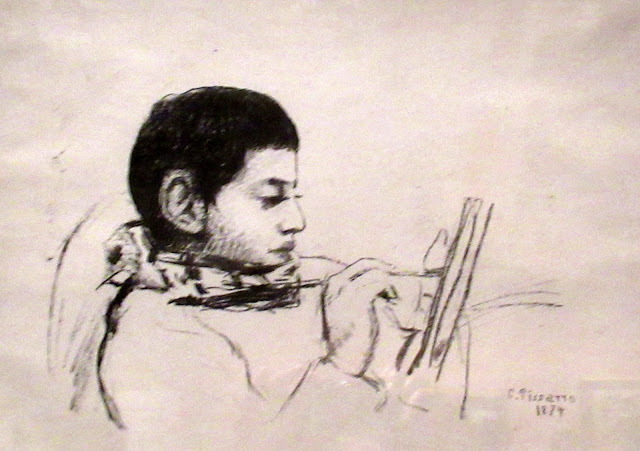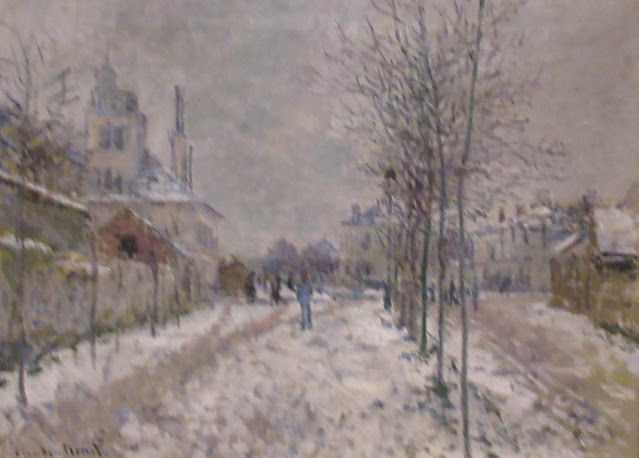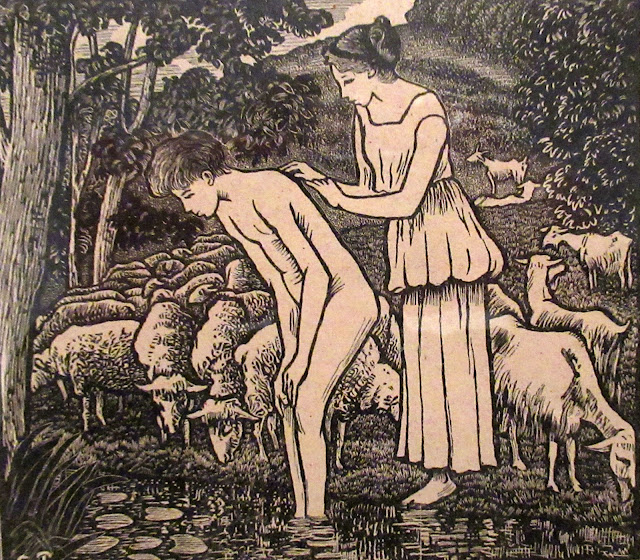Pissarro, Father of Impressionism
Before Impressionism:
In 1855 Pissarro moved from the Danish West Indies, where he had grown up, to Paris. The artists who had the greatest impact on him were part of a recent movement concerned with realism in their landscape painting. Daubigny's paintings of lakes and rivers particularly struck a chord with Pissarro. He also took informal lessons with Corot, who encouraged him to paint outdoors. While these artists were breaking new ground, they were still accepted by the conservative 'Academy of Fine Arts' whose approval gave them commercial credibility.
In 1860-61, Pisssarro attended the Academie Suisse, an unconventional art school where he met a group
of younger painters including Claude Monet and Paul Cezanne, who were looking for a modern way of working. All were determined not to compromise their art to conform to Academie expectations. With Pissarro as the driving force, they began to organise their own independent exhibitions. The paintings below show the early deveopment of the style we now know as Impressionism.
The complicated blooms are created with a brush loaded with pigment, while the leaves and background are more thinly painted.
The Countryside near Louveciennes, Summer 1870, (oil on canvas)
The overall lightness of the picture, the paint at times almost translucent, is a different way of painting from Pissarro's earlier work. Small patches of brilliant colour, a red roof, or a blue one, appear here and there against the simple vatiants of green and brown of which Pissarro was particularly fond. A sense of the houses as real homes, and the inclusion of figures who belong to the scene are characteristic features of Pissarro's art.
Portrait of Paul Cezanne, 1874, (oil on canvas)
This portrait shows a characteristically rumpled Cezanne, still in his coat and hat, sitting in Pissarro's studio. Behind him, Pissarro has placed images revealing their shared political and artistic opinions - a caricature of the despised conservative statesman Adolphe Thiers on the left, and on the right, fellow artist Gustave Courbet standing up to the tyranny of the Salon.
Pissarro deliberately flattens the perspective. The trees in the foreground and the houses in the background both appear in the same plane. In spite of the density of work on the plate, it retains an airy luminosity.
Impressionism:
In the late 1860s, Pissarro and his friends, especially Monet and Cezanne, began to experiment with increasingly radical compositions: unexpected viewpoints, diagonal roads creating off-centred layouts.
In Pissarro's works, the human figure became increasingly important. Unlike Monet and Renoir, he did not paint the middle classes at play, but the farmers and shepherds at work in the fields and orchards, or selling their produce in the local market. The people in Pissarro's paintings represent a political as well as an artistic statement They represent an honourable life in a landscape not yet destroyed by industrialisation.
Fan: The Harvesters, 1880, (tempera on silk)
Degas encouraged Pissarro to try painting on silk fans. They were both a technical challenge and a potentially popular novelty. (They were never intended to be mounted on sticks and actually used).
Degas painted scenes of city life, while Pissarro created scenes of farmworkers engaged in a cycle of agricultural tasks. The cohesion of this group of harvesters, standing in relief against the light, emphasises their co-operation.
The Horse Market, 1883, (tempera on silk)
Monet had long ago discovered the colours to be found in shadows and reflections on snow. Here, snow is the principal character, softening the edges of everything even the meagre trees.
Compositional study for 'Women Working in the Fields', 1894, (pen and Indian ink with watercolour over charcoal)
Women Working in the Fields, 1894, (wood engraving printed in colour from six blocks on wove paper)
Women Working in the Fields, 1894, (wood engraving coloured with watercolour)
Study for A Woman Lying on the Ground, 1882, (black chalk with charcoal and some pastel heightened with bouache)
Pissarro's sophisticated method of preparing for his major oil paintings in the 1880s increasingly involved large drawings of single figures. In this powerful example, the figure was first sketched in black chalk, with the dress redrawn in charcoal and the headscarf added in pastel.
This work concentrates on what Pissarro called the 'sensation' suggested by the agricultural activity in the small fields and cottage gardens.
Paul Gauguin, Interior with Aline, 1881, (oil on canvas)
Gauguin's respect for Pissarro in his early career is often overlooked, but it was Pissarro who persuaded the amateur artist to give up his job as a stockbroker and paint full-time, although they later fell out and Gauguin alienated himelf from all the other Impressionists.
Apples and Pears in a Circular Basket, 1872, (oil on canvas)
Paul Cezanne, Milk Can and Apples, 1879, (oil on canvas)
Both Pissarro and Cezanne used still life compositions as radical experiments in how to create forms using colour, rather than outline and shading. Cezanne was moving beyond the Impressionists' aim of reproducing what they saw. He believed it was impossible for the mind not to intervene. Cezanne shows the table as if seen simulataneously from the side and from above, which is impossible in a single moment, but does correspond with how we might experience looking at a table of objects.
Paul Cezanne, The Cote Saint Denis, at Pontoise, 1877, (oil on canvas)
Pissarro and Cezanne met at the informal classes held at the Academie Suisse in 1861, and remained friends throughout their lives. In the 1870s, they were at their closest artistically - both developing their individual interpretations of Impressionism.
Cezanne frequently walked from his house at Auvers-sur-Oise to spend the day working side by side with Pissarro at Pontoise. In this painting and the one below by Pissarro, even though the two views are not from exactly the same position, both show the same group of houses in Pontoise seen through trees. Both artists are working with short, staccato brushstrokes, creating an almost abstract effect. Towards the end of his life, Cezanne said that it was from PIssarro that he learnt to work properly: 'old Pissaro was a father to me. He was someone to go to for advice and something like the good Lord'.
The Cote des Boeufs, L'Hermitage, 1877, (oil on canvas)
Three women trudge along a narrow country road carrying heavy bundles of firewood. The subject is typical of Pissarro's new interest in the hardships of country life. It was made for the anarchist writer, Jean Grave, to support his journal, Les Temps Nouveaux. Pissarro's lithographs of rural life reflect both his political beliefs and the protracted crisis in farming in the 1890s.
Neo-Impressionism:
In 1885, Pissarro was introduced to an innovative style of painting using individual dots of colours. Georges Seurat and Paul Signac were friends of Pissarro's eldest son Lucien. Seurat had been researching the latest optical theories confirming that dots or strokes of contrasting colours were were blended by the eye and mind of the viewer. Dots of unmixed opposite or 'complementary' colours created a particularly luminous effect.
Pissaro temporarily adopted the method, and at the eighth (and last) Impressionism exhibition held in 1886, their experiments were shown in a separate room. It was a natural development away from the spontaneity of Impressionism towards a more considered and formalised art.
In the early months of 1896, Pissarro painted 15 canvases of views from his hotel room in Rouen. He worked on several at once, in order to have enough time to capture the passing effects of traffic and weather. The motif which most interested him was this iron bridge over the river Seine, 'with a great commotion of carriages, strollers, stevedotes, boats, smoke, haze in the distance, full of life and movement'.
The 'dot' technique here creates a shimmering background for an image of sunlit, co-operative work and rural fruitfulness. The high horizon allows concentration on the tree, placed just off-centre. This particular tree with its distinctive kink was clearly a favourite as it appears in several images.
Like his father, Lucien enthusically embraced the new 'dot' technique.
Pissaro decribed the composition as 'primitive modern' and was in despair when his dealer told him it was unsaleable. The complex composition shows the view from the first foor of the house at Eragny, looking over the poultry yard to the left, which was separated by the red roof from the kitchen garden on the right. Beyond are the meadows between the villages of Eragny and Bazincourt.
Seurat's methodology was not confined to manipulating colour. He was also interested in recent theories about composition - for example, the proposal that horizontals conveyed balance, calmness order, clarity and light. However, the mystery of this picture, alternating as it seems to do between flatness and depth, is the result of Seurat's own unobtrusive mastery of pointillism, which he preferred to call 'divisionism'.
Van Gogh met Lucien and Camille in 1886, having recently arrived in Paris. The three became close and Vincent's exposure to Neo-Impressionism encouraged him to explore colour theories. He abandoned the realist style he had developed in Holland and, as here, adopted a much lighter palette. It was Pissarro, who introduced Van Gogh to the homeopathic doctor Paul Gachet (Cezanne and Pissarro's partner in printing) and under whose care Vincent spent his final months.
Design for a fan: The Pea Stakers, 1890, (oil on canvas)
Pissarro began to move away from the hardships of rural life to evoke a rural Arcadia where toil is replaced by graceful labour. This fan, a present to his son Lucien, shows a group of peasant women in the orchard at Eragny. Between the blossoming apple trees, they are planting the poles to train the pea plants at their feet. Their rhythmical movement seems to evoke a pastoral dance.
By 1890, Pissaro had abandoned Neo-Impressionism. As well as being enormously time-consuming, he felt that the constraints of the method 'tie me down and prevent me from reproducing the spontaneity of the sensation'. His late paintings show him returning to a freer, more painterly style.
This extraordinary period of creativity was bolstered by the acquisition of a printing press in 1894. Pissaro made ethings and lithographs, the latter often overtly political in content.


















































No comments:
Post a Comment